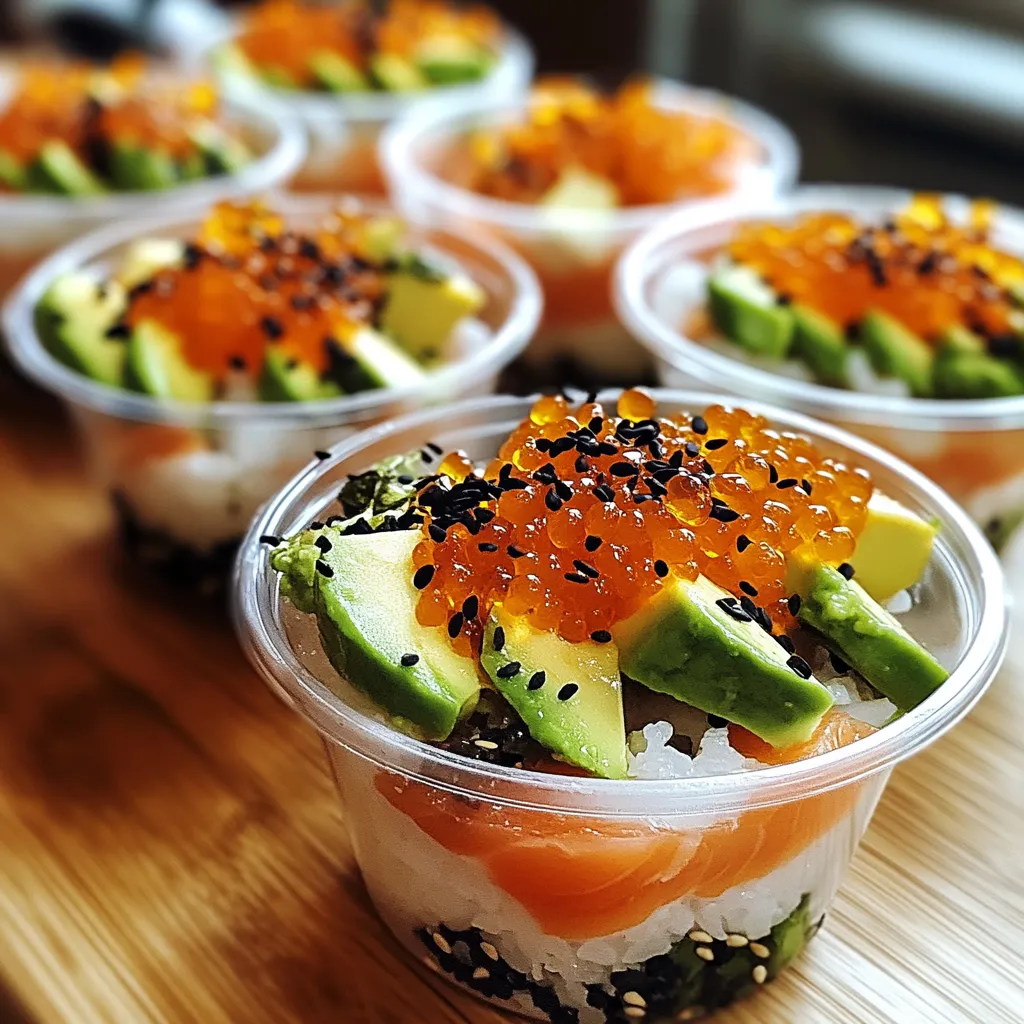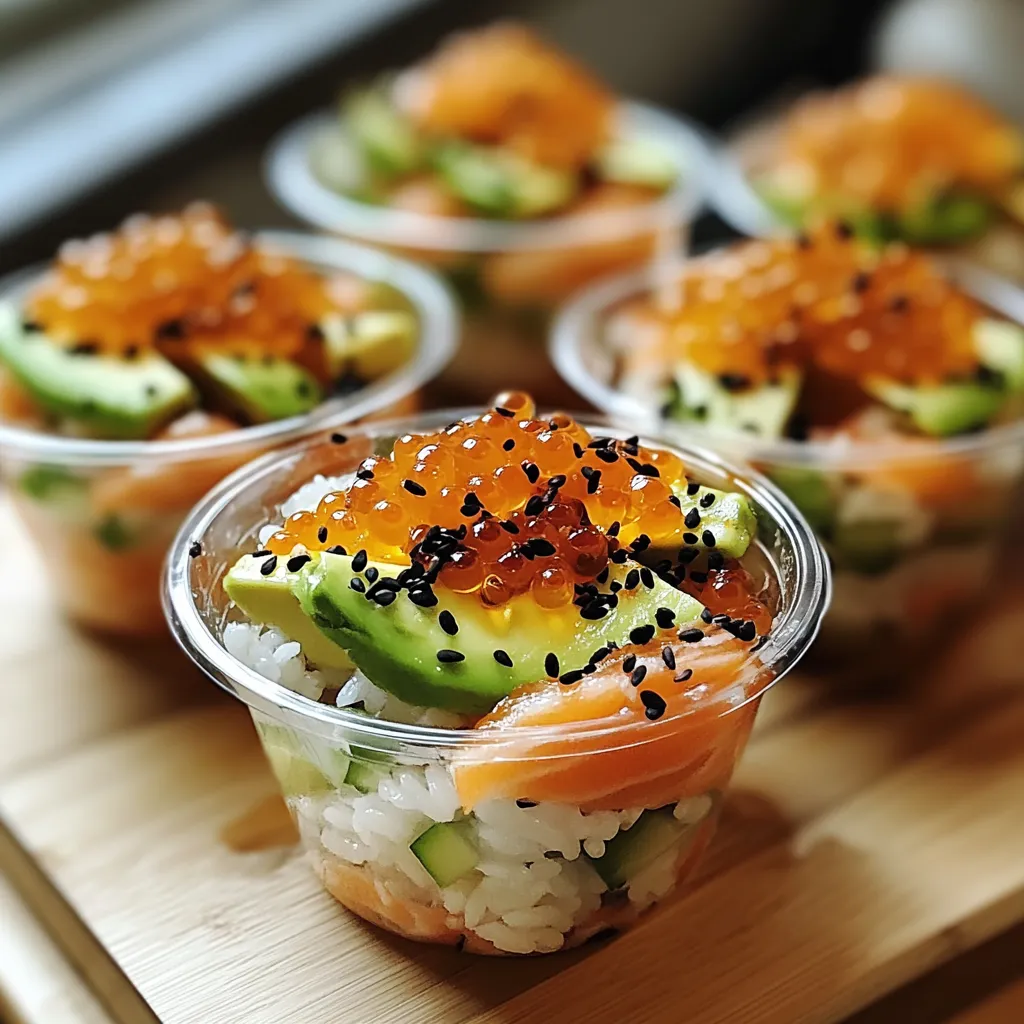 Pin it
Pin it
Beautiful bite-sized vessels filled with perfectly seasoned sushi rice and crowned with jewel-toned fresh fish and crisp vegetables create an impressive yet approachable take on traditional sushi. These delightful cups deliver all the beloved flavors of classic rolls without requiring any special rolling techniques or equipment. Each colorful creation offers the perfect balance of tender rice, buttery fish, and crisp vegetables in a single, satisfying bite that captures the essence of Japanese cuisine while adding a contemporary twist perfect for entertaining.
The first time I served these at a dinner party, my guests were absolutely delighted by the presentation. My friend's seven-year-old daughter, who had always refused to try sushi, eagerly grabbed one and proclaimed it "the prettiest food ever" before taking a tentative bite. Her eyes widened with surprise, and she immediately reached for another. Now whenever we host gatherings, she specifically asks if "those little sushi cups" will be on the menu. They've become my secret weapon for introducing hesitant eaters to the wonderful world of sushi flavors.
Fresh Treasures
- Sushi rice: The foundation of these cups provides the perfect sticky texture needed for shaping; proper rinsing and seasoning transform ordinary short-grain rice into something special
- Fresh sushi-grade fish: Select the highest quality salmon, tuna, or other seafood from a reputable fishmonger; its vibrant color and oceanic freshness make these cups truly exceptional
- Ripe avocado: Contributes buttery richness that balances the acidic rice and clean flavors of raw fish; choose specimens that yield slightly to gentle pressure
- Crisp cucumber: Adds refreshing crunch and coolness that complements the other ingredients beautifully; English or Persian varieties offer fewer seeds and firmer texture
- Colorful carrots: Provide vibrant color and subtle sweetness; julienne them finely for the best textural contrast and visual appeal
- Nori sheets: Optional but add authentic flavor and help cups maintain their structure; their deep umami notes enhance the overall experience
- Sesame seeds: Bring subtle nuttiness and visual interest as a finishing touch; toasting them briefly intensifies their flavor dramatically
Sushi Symphony
- Prepare perfect rice:
- Begin with 1½ cups sushi rice, rinsing thoroughly under cold water until the water runs clear. This crucial step removes excess starch and ensures ideal stickiness. Cook with 2 cups water according to package instructions, typically bringing to a boil, then simmering covered for 20 minutes before resting, covered, for 10 additional minutes. While still warm, gently fold in a mixture of 2 tablespoons rice vinegar, 1 tablespoon sugar, and 1 teaspoon salt until evenly distributed. Allow to cool to room temperature, fanning occasionally to achieve the perfect glossy texture.
- Prep fresh components:
- While the rice cools, prepare your toppings. Slice 1 pound of sushi-grade fish into small, uniform cubes approximately ¼-inch in size. Julienne 1 cucumber and 1 medium carrot into matchstick-sized pieces. Cut 1 ripe avocado into thin slices just before assembly to prevent browning. Combine 1 tablespoon sesame oil with 1 tablespoon soy sauce in a small bowl to create a simple but flavorful drizzling sauce. Chop green onions and have sesame seeds ready for garnishing. This advance preparation ensures smooth assembly.
- Create your cups:
- Line a 12-cup muffin tin with plastic wrap for easy removal, or use individual serving cups if preferred. For a more authentic touch, place small squares of nori at the bottom of each cup before adding rice. Press approximately 2 tablespoons of seasoned rice into each cup, creating a slight depression in the center to hold the toppings. The rice should be compacted enough to hold its shape but not pressed so firmly that it becomes dense and heavy. If using nori, allow the edges to extend slightly beyond the rice for an attractive presentation.
- Assemble with artistry:
- Arrange your prepared toppings artfully on top of each rice cup, distributing colors and textures for maximum visual impact. Layer fish, avocado slices, and julienned vegetables, thinking about color contrast and balance. Drizzle lightly with the sesame-soy mixture, then finish with a sprinkle of sesame seeds and finely chopped green onions. For maximum flavor, serve immediately or refrigerate briefly (no more than 1 hour) before serving. The cups should pop easily out of the molds when lifted by the plastic wrap edges.
 Pin it
Pin it
I still remember the valuable lesson I learned from a Japanese chef friend who watched me hastily mix my sushi rice. She gently took the bowl from me, demonstrating how to cut and fold the vinegar mixture into the rice rather than stirring, which would crush the grains and create a gummy texture. "Treat each grain with respect," she explained, showing me how proper technique preserves the individual texture of each rice grain while distributing flavor. This simple adjustment transformed my sushi rice from adequate to exceptional, and I've prepared it this way ever since.
Elegant Accompaniments
These versatile cups pair beautifully with complementary sides that enhance the sushi experience. Serve alongside small dishes of additional soy sauce, pickled ginger, and wasabi for authentic flavor customization. For a more substantial meal, accompany with a light miso soup and a crisp Asian-inspired salad dressed with rice vinegar and sesame oil. A chilled cucumber salad with rice vinegar makes a refreshing palate cleanser between different varieties. For beverages, offer cold sake, Japanese beer, or green tea – all traditional accompaniments that harmonize perfectly with the clean flavors of these sushi cups.
Creative Variations
The basic recipe welcomes thoughtful adaptation to suit different preferences and dietary needs. Create a California-style cup by substituting imitation crab (or real crab for luxury), avocado, and cucumber, topped with a small dollop of Japanese mayonnaise. For a vegetarian option, replace fish with marinated tofu, pickled daikon radish, and additional vegetables. Spice lovers might enjoy a "spicy tuna" version, mixing diced tuna with sriracha and mayonnaise before topping the cups. For a cooked option perfect for those hesitant about raw fish, use poached shrimp or teriyaki-glazed salmon pieces instead of raw fish.
Fresh Preservation
These delicate creations are best enjoyed soon after assembly, but proper storage techniques can maintain their quality for limited times. If preparing ahead for a party, keep the rice cups covered and refrigerated separately from your prepared toppings, assembling just before serving for maximum freshness and visual appeal. Any leftover assembled cups can be stored in the refrigerator for up to 24 hours, though the rice may become slightly firmer. To revive leftover cups, allow them to come to room temperature for 10-15 minutes before serving, and add a fresh drizzle of sauce to restore moisture and flavor.
These elegant sushi cups represent the perfect balance between tradition and innovation, offering all the beloved flavors of sushi in a format that's both approachable and impressive. They prove that with quality ingredients and thoughtful preparation, home cooks can create restaurant-worthy Japanese-inspired cuisine without specialized training. Whether served as sophisticated party appetizers or enjoyed as a special family dinner, these colorful bites bring joy to both the eye and the palate.
 Pin it
Pin it
Frequently Asked Questions
- → Do I need special equipment to make sushi cups?
- No special equipment is required! While a rice cooker is helpful, you can cook rice on the stovetop. For molding, you can use a muffin tin, small ramekins, cookie cutters, or even shape them by hand using plastic wrap.
- → What if I can't find sushi-grade fish?
- If sushi-grade fish isn't available, you can use fully cooked seafood alternatives like poached shrimp, crab meat, smoked salmon, or even make them vegetarian with extra avocado, cucumber, and carrots.
- → Can I make these ahead of time?
- You can prepare the rice and fillings ahead of time, but for best taste and texture, assemble the cups just before serving. Sushi rice hardens when refrigerated, and avocado can brown quickly.
- → How do I know if fish is sushi-grade?
- Sushi-grade fish should be clearly labeled as such at a reputable fishmonger or grocery store. It should be very fresh, with no fishy smell, and have been properly frozen to kill potential parasites.
- → What can I serve with sushi cups?
- Serve with traditional sushi accompaniments like soy sauce, wasabi, and pickled ginger. For a fuller meal, pair with miso soup, a simple cucumber salad, or edamame.
- → Are there any shortcuts to make this recipe quicker?
- To save time, you can use pre-cooked sushi rice (available at some Asian markets), pre-julienned vegetables, and cooked seafood options. Just assemble and serve for a quick but impressive appetizer.
